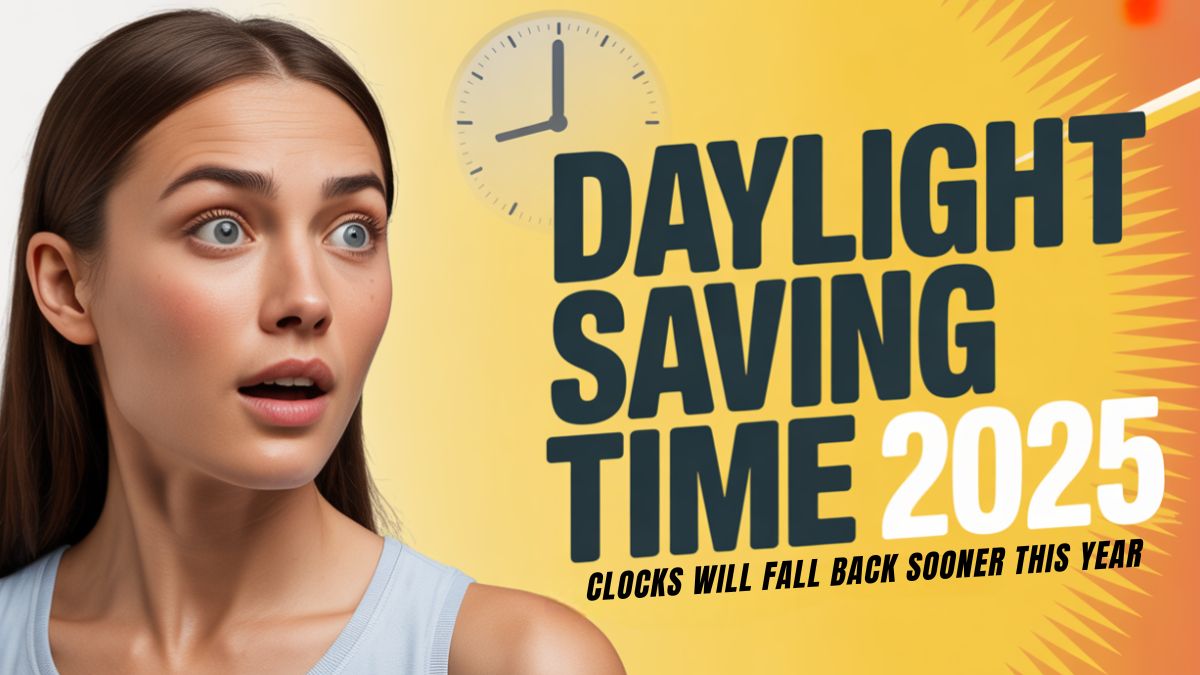Every year in the United States, when October and November roll around, an old tradition disrupts people’s routines—the end of Daylight Saving Time and the setting back of clocks by one hour. Even in our digital world, this change still confuses many. While phones and laptops update automatically, the clock on the wall, the kitchen timer, or that old alarm clock often remain out of sync for a few days.
This year will be no different. On Sunday, November 2, 2025, at 2 a.m., the U.S. will “fall back,” and clocks will be set back one hour. This will make the days feel shorter, the cold will intensify, and evenings will arrive much earlier. This raises the question once again—is this tradition still relevant to our time and lifestyle, or is it simply a historical habit that we have carried on to this day?
What is Daylight Saving Time? A Simple Idea That Became a National Rule
The basic idea behind Daylight Saving Time was quite simple. Days are longer in the summer, so it was thought that if clocks were moved forward by an hour, people could utilize more daylight in the evenings. This would save energy and make daily life feel a little easier.
DST was officially established in 1966 under the Uniform Time Act. Since then, clocks have been moved forward one hour on the second Sunday of March and back one hour on the first Sunday of November each year.
Initially, it was considered a practical solution. Electricity was limited at the time, and people wanted to make the most of daylight. Even today, many argue that DST keeps evenings brighter and gives working people the opportunity to spend time outdoors after work.
But society has changed. A 24-hour economy, LED lighting, the internet, stores and facilities that are open all night—all of these raise the question of whether a tradition like DST is still as important as it once was.
The History of DST: Amidst Wars, Industries, and Technological Changes

DST was not just a domestic convenience. It was first introduced on a large scale during the World Wars to conserve fuel and electricity. Resources were limited during wartime, and governments wanted people to make greater use of natural light.
Even after the wars, many countries adopted DST. In the US, industries supported it because it provided more daylight in the evenings, encouraging people to go out and shop. It was beneficial for malls, the entertainment industry, and sporting events.
However, as technology advanced, DST’s contribution to energy saving diminished. Now, LEDs and modern appliances consume less electricity. Also, due to appliances like air conditioners and heaters, energy demand remains high in many states anyway. As a result, the benefits of DST have gradually decreased.
2025 Calendar: When does DST begin and end?
In 2025, DST began on March 9th. The final day will be November 2nd, when the clocks will be turned back one hour, marking the end of summer.
During the summer months, people enjoy spending time outdoors, playing sports, traveling, and spending time with family after work. Supporters of DST say it provides an opportunity to enjoy longer days. However, critics argue that it has simply become a habit and its real benefits are diminishing.
An extra hour of sleep—is it truly restful or stressful for the body?
When DST ends, people feel like they are getting an extra hour of sleep. Initially, this seems like a relief, but this relief is not as simple as it seems.
The human body operates on a specific sleep cycle called the circadian rhythm. This cycle is very sensitive and is affected even by small changes in time.
Shift workers, parents of young children, elderly individuals, and those already struggling with sleep problems are more affected after the time change.
Data from the American Sleep Research Institute shows that in the days immediately following the time change:
- The number of road accidents increases.
- A slight increase in cases of heart disease is observed.
- Mistakes at work and a decrease in productivity are reported.
- People experience increased irritability and mood swings.
Considering all these factors, many experts believe that changing the clocks twice a year now puts unnecessary stress on the body.
The Growing Debate Between Politics and the Public
Opinions both for and against DST continue to surface. In April 2025, former President Donald Trump stated that DST should be made permanent because changing clocks has become a bothersome experience.
However, just a few months earlier, he had also said that DST should be abolished altogether.
This contradiction shows that DST is not just a technical change. It is a subject connected to people’s lifestyles, children’s school schedules, traffic, safety, and major political decisions.
Many people prefer brighter evenings because they allow more time for family and social activities. On the other hand, brighter mornings are more important for schoolchildren and those who leave for work early in the morning.
Stalled Bills in Congress and Differing State Approaches
Discussions about DST have been ongoing in the US Congress for years, but without results. In 2022, the Sunshine Protection Act was passed, aiming to make DST permanent. This bill passed the Senate but stalled in the House.
It was reintroduced in 2025, but no concrete steps have been taken yet.
Meanwhile, the movement is rapidly growing in several states.
In March 2025, Pennsylvania appealed to Congress to end this old tradition. In the past few years, more than 29 states have made the same demand.
Some states and US territories still do not observe DST:
- Hawaii
- Most of Arizona
- Puerto Rico
- Guam
- American Samoa
- U.S. Virgin Islands
- Northern Mariana Islands
The governments of these places believe that DST is unnecessary and that natural time works better.
November 2, 2025: The Day of Change
On Sunday, November 2, at 2 a.m., clocks will be turned back one hour to 1 a.m. This will make mornings brighter but evenings shorter.
The beginning of winter is also felt around this time. The sun will set earlier, temperatures will drop, and people will gradually start spending more time indoors. For some, this change will be a welcome opportunity for rest—extra sleep, a little relaxation.
For others, it may bring a few days of discomfort and physical fatigue.
Is DST an outdated tradition?
The purpose of DST was to save energy and make better use of daylight. But modern research shows that energy savings from DST are now minimal—less than 1%.
Conversely, its effects on health, sleep, mental state, and road safety are now more apparent. Given such minimal savings, the question arises whether it is reasonable to disrupt people’s bodies and lives twice a year.
Will DST end?
Many hope that DST will be abolished or made permanent in the coming years. But due to political differences, regional needs, and varying demands from different states, this decision continues to be postponed.
Until a clear law is agreed upon, Americans will have to set their clocks forward in March and back in November.
Conclusion: An extra hour of sleep and an equally deep debate
When DST ends in 2025, you will certainly get an extra hour of sleep. But along with it, the debate about whether this tradition is still necessary will also resurface.
When you set your clock back this year, it’s natural to wonder if we should adopt permanent time.
DST is not just about changing clocks. It is a topic deeply connected to our daily routines, energy use, mental health, social activities, and national policies.
While enjoying that extra hour of sleep, it’s important to understand that even small things have a big impact on our daily lives and health. Perhaps it’s time to reconsider old traditions like DST.
FAQs
Q. When will Daylight Saving Time end in 2025?
A. Daylight Saving Time will end on Sunday, November 2, 2025, when clocks will be set back one hour.
Q. Why do people set clocks back during DST?
A. Clocks are set back to return to Standard Time and adjust for shorter daylight hours in winter.
Q. Does the time change affect health?
A. Yes. It can disrupt sleep patterns, cause fatigue, and temporarily affect mood and focus.
Q. Which states do not follow DST?
A. Hawaii, most of Arizona, Puerto Rico, Guam, American Samoa, the U.S. Virgin Islands, and the Northern Mariana Islands do not observe DST.
Q. Is the U.S. planning to end DST permanently?
A. There is ongoing debate, and several bills have been proposed, but no final national decision has been made yet.
